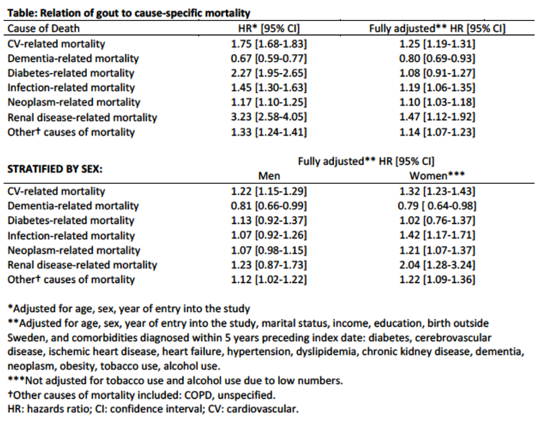Session Information
Session Type: ACR Concurrent Abstract Session
Session Time: 4:30PM-6:00PM
Background/Purpose:
There is recognized higher mortality among gout patients, with cardiovascular (CV) mortality having been previously reported. The present study aimed to examine cause-specific mortality beyond CV diseases in patients with gout compared to general population.
Methods:
We used the Swedish SkŒne Healthcare Register, which contains data regarding healthcare visits for all residents of the large region, and the Causes of Death Register (high validity), both with diagnoses registered according to International Classification of Diseases, version 10 (ICD-10) system. We identified subjects with incident gout (ICD-10: M10) diagnosed between 2003 and 2013. We matched each person with gout with up to 10 comparators free of gout by age and sex. Subjects were followed from the date of gout diagnosis or a matching index date for the comparators until relocation outside SkŒne, death or end of study period (12/31/14). Using information on the underlying cause of death, we estimated hazard ratios (HR) of mortality for specific causes of death in a multi-state Cox model accounting for competing risks, adjusting for potential confounders (Table), and also stratified by sex.
Results:
Among a source population of 832,258 subjects, there were 19,497 persons with an incident gout diagnosis who were matched with 194,947 comparators free of gout. Persons with gout had higher prevalence of chronic kidney disease, metabolic and CV comorbidities, but lower prevalence of dementia than comparators. The all-cause mortality rate per 1000 person-years was 63.6 among those with gout and 47.3 among those without gout. The causes of death among those with and without gout, respectively, were: CV diseases, 49.5% and 41.4%; neoplasms, 18.2% and 21.9%; diabetes, 3.4% and 2.2%; infections, 5.7% and 5.8%; kidney diseases, 1.6% and 0.8%; dementia, 3.8% and 8.4%. Gout was associated with an 18% increased risk of all-cause mortality (HR 1.18, 95% CI 1.14-1.21). In terms of cause-specific mortality, the largest association was seen for the relation of gout to risk of death due to renal disease (HR of 1.47) (Table). Gout was associated with lower risk of death due to dementia (HR 0.80), while elevated risk of CV-related mortality in gout was confirmed (HR 1.25). While men had higher mortality overall, in the stratified analyses, the effect of gout on cause-specific CV-, infection-, neoplasm-, and renal-related mortality was modestly higher among women than men, potentially reflecting generally lower baseline risk of mortality in women (Table). Similar results were obtained with the Fine & Gray method.
Conclusion:
A novel finding is the ~50% increased risk of renal-related mortality among gout patients that highlights the need for improved understanding and management of gout and kidney disease. The finding of ~20% lower dementia-related mortality calls for attention to the relation between hyperuricemia and dementia.
To cite this abstract in AMA style:
Vargas-Santos AB, Neogi T, Castelar-Pinheiro G, Turkiewicz A. Cause-Specific Mortality in Gout: Novel Findings of Elevated Risk of Renal-Related and Decreased Risk of Dementia-Related Death [abstract]. Arthritis Rheumatol. 2017; 69 (suppl 10). https://acrabstracts.org/abstract/cause-specific-mortality-in-gout-novel-findings-of-elevated-risk-of-renal-related-and-decreased-risk-of-dementia-related-death/. Accessed .« Back to 2017 ACR/ARHP Annual Meeting
ACR Meeting Abstracts - https://acrabstracts.org/abstract/cause-specific-mortality-in-gout-novel-findings-of-elevated-risk-of-renal-related-and-decreased-risk-of-dementia-related-death/

